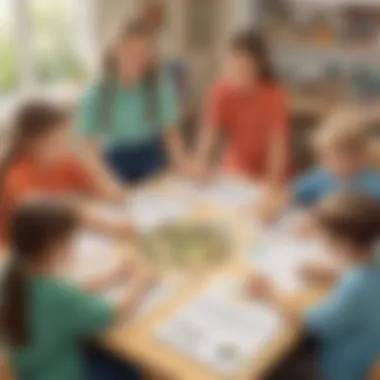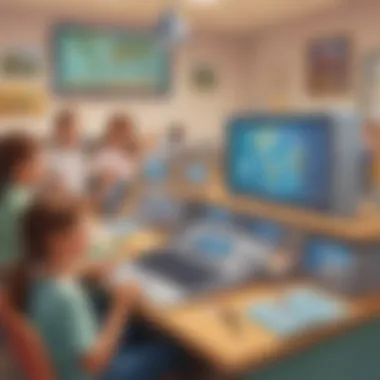Blending Activities in Education: A Comprehensive Guide


Intro
Blending activities in educational settings profoundly impact learning outcomes for elementary school children. These activities integrate traditional teaching methods with modern approaches, providing a holistic experience that fosters intellectual curiosity. This article delves into the importance and implementation of blending activities, equipping educators and caregivers with strategies that enhance engagement and promote effective learning.
Creative Activities
Craft Ideas
Creative crafts can spark joy and learning in children. Engaging in crafting enhances fine motor skills, artistic expression, and imaginative thinking. Simple ideas can spur creativity, such as making a paper plate animal or creating a collaged landscape using old magazines. Materials for these activities are usually easy to find at home or school, making them accessible to all.
Step-by-Step Guides
Following a structured approach can improve the crafting experience. For example, creating a paper plate animal may go as follows:
- Gather materials: paper plates, colorful paper, glue, scissors, markers
- Design the animal: Children choose an animal and determine its features.
- Cut out the pieces: From the colorful paper, they cut shapes such as ears, tails, and other body parts.
- Assemble the pieces: For this, children stick all parts onto a paper plate.
- Add details: Using markers, they can draw eyes, patterns or even a habitat.
Educational Value
Investing time in crafts holds various educational benefits. It can develop creativity, which assists problem-solving skills. Additionally, during craft activities, children enhance collaboration skills when working in teams. The fusion of art with other subjects, such as science or history, sparks deeper interest and results in enhanced knowledge retention.
Fun Quizzes
Quiz Topics
Quizzes engage children's minds in a compelling way. Topics may vary widely, covering science, geography, history, and mathematics. For example, quizzes on plants, animals or major world landmarks help reinforce what kids learn in class.
Question Types
The variations in question types can maintain interest. These include true or false questions, multiple choice, and fill-in-the-blank formats. Each style offers a different degree of challenge, allowing children to explore freely while still learning.
Knowledge Reinforcement
Quizzes play a key role in reinforcing knowledge. Through repetition and practice, kids can fortify their understanding. Furthermore, answering questions often captures them better than traditional tests by promoting a more informal learning atmosphere.
Foreword to Blending Activities
Blending activities are a crucial aspect of modern education, particularly in the realm of elementary education. As educators aim to cultivate a rich learning environment, the integration of various teaching methods is essential. This approach involves combining traditional hands-on learning with digital tools, creating an interactive experience. The primary goal is to enhance students' engagement and improve their academic outcomes. Furthermore, blending activities allow for a more dynamic classroom where different learning preferences can be catered to effectively.
Defining Blending Activities
Blending activities refer to instructional techniques that fuse classroom-based learning with online components. In practice, this means that students may engage in hands-on projects and discussions while also utilizing digital resources such as educational software and virtual collaboration tools.
This merger of methods aims to create a more holistic educational approach. Educators can design tasks that require students to conduct research on a computer, then translate their findings into a classroom project or presentation. Therefore, blending activities should not be seen as merely incorporating technology; rather, they are about strategically melding various forms of learning to optimize student experience and success.
Importance in Elementary Education
In elementary education, every learning moment counts. At this stage, children are developing critical foundational skills, which is where blending activities can play a pivotal role. The implementation of blended activities fosters motivation and encourages active participation. Children often find technology engaging, which provides a unique opportunity for teachers to grab their attention and maintain interest throughout lessons.
Among the key reasons for integrating blending activities in primary education are:
- Increased Engagement: Children are more likely to participate when lessons include diverse elements, such as technology.
- Personalized Learning: Online resources can adjust to cater different levels of understanding, making it easier for each child to connect with the material.
- Collaboration Skills: Blended tasks regularly involve teamwork, introducing students to essential interpersonal skills.
With thoughtful execution, blending activities can transcend the limitations often found in traditional teaching methods, enriching the overall educational experience and aligned with the unique ways children learn today.
Types of Blending Activities
The concept of blending activities in educational settings revolves around creating an environment that merges different learning methodologies. This section explores the various types of blending activities, highlighting their advantages and considerations for effective implementation. By integrating traditional and modern forms of education, educators can create powerful learning experiences that are both engaging and effective for elementary school children.
Hands-On Learning
Hands-on learning is crucial in engaging students on a deeper level. It allows children to physically interact with materials, thus promoting exploration and active involvement. This type of learning fosters curiosity and encourages learners to ask questions. Experiments in science or building mathematical concepts using blocks illustrate this types' strengths. Students do not just memorize facts; they experience learning in a tangible way.
Research shows that hands-on experiences rooted in real-life contexts greatly enhance cognitive understanding


Examples of Hands-On Learning:
- Science Experiments: Conducting simple experiments in a science class.
- Art Projects: Using clay to create sculptures encourages creativity and tactile skills.
- Building Projects: Engineering activities involving kits or recycled materials.
Digital Integration
Digital integration encompasses the use of technology to enhance educational outcomes. With technology increasingly present in daily life, including it in learning engages students. Digital tools, such as tablets and educational software, can present tailored exercises and track progress over time.
Considerations for digital integration must include ensuring students are proficient with the tools required, ensuring technology does not replace essential teaching elements, and monitoring screen time.
Benefits of Digital Integration:
- Accessibility to diverse educational content.
- Real-time feedback from quizzes and interactive sessions.
- Encouragement of independent learning pathways for students.
Collaborative Projects
Collaboration is an essential skill for students to develop during the early years. Collaborative projects allow students to work together in teams, learning to share responsibility, communicate, and contribute to shared goals. This type of blending activity can take various forms, including group assignments or community projects.
Advantages of Collaborative Projects:
- Develops interpersonal skills crucial for future endeavors.
- Encourages respect for different viewpoints and ideas.
- Fosters collective problem-solving abilities among students.
Engaging students in these settings promotes leadership potential, understanding of group dynamics, and the pleasure of achieving results as a team.
Interactive Quizzes and Games
Interactive quizzes and games mix learning with entertainment. They serve not only as assessment tools but also as avenues to practice skills in a less formal context. This format encourages competitive spirit and curiosity, making essential review sessions enjoyable for students.
Educational platforms often include games that adapt to students' knowledge levels, providing tailored practice. Finding balance in gameplay and informative content is important in this approach.
Aspects of Interactive Quizzes and Games:
- Visual stimulation helps maintain student interest.
- Immediate feedback on answers enhances learning.
- Collaboration in game settings fosters healthy competition and teamwork.
By understanding and effectively implementing these types of blending activities, educators will better prepare elementary school children for future academic and social challenges.
Strategies for Implementing Blending Activities
Blending activities in education is essential for creating a dynamic learning environment. Effective integration of these activities requires thoughtful strategies. Consideration of specific elements is key. Setting clear objectives, choosing adequate tools, and establishing an inclusive learning environment fosters a more engaging atmosphere for students. Respective strategies equip educators to maximize the benefits and effectiveness of blending activities, tailoring lessons to the specific needs of elementary school children.
Setting Clear Objectives
Establishing clear objectives is crucial for guiding learning experiences. Objectives give direction to both educators and students about what to achieve. When objectives are defined well, they help students understand the purpose and outcomes of the activities. This awareness influences motivation and engagement.
Here are some tips for setting effective learning objectives:
- Ensure they are specific and measurable.
- Align them with educational standards.
- Involve students in the process. This engagement fosters ownership.
To illustrate, an activity involving technology might aim to improve scientific inquiry skills. Thus, an objective could be: "Students will formulate a testable question and collect data using digital tools."
Choosing Appropriate Tools
Selecting appropriate resources is a vital aspect of implementing blending activities. Tools can range from educational software to interactive gadgets. Tools should reflect students' needs and complement the goals set earlier. The effectiveness of an activity significantly hinges on tool selection.
Consider these aspects when choosing tools:
- Assess the students' technical skills and comfort level with the tools.
- Evaluate the integration capabilities with existing curricula.
- Look for resources that enhance, not complicate, the learning experience.
Examples of suitable tools include Kahoot! for quizzes and assessments, Padlet for collaborative brainstorming, and Google Classroom for assignment management.
Creating an Inclusive Environment
An inclusive environment is vital for fostering participation from all students. Accessibility, diversity, and respect for individual learning styles should play a central role. When blending activities, consider the varied backgrounds and competencies of students, fostering an atmosphere where every child feels welcomed to contribute.
There are some effective ways to nurture inclusivity:


- Differentiate to meet various learning needs; expand strategies to reach all learners.
- Encourage collaboration among diverse student groups. This interaction promotes empathy and understanding.
- Ensure the activities support cultural and individual diversities.
A strong focus on inclusivity helps all students find value in blending activities, enhancing not just learning outcomes but personal growth as well.
To wrap it up, clear objectives guide the process, the right tools enrich experiences, and an inclusive approach fosters engagement. Together, these strategies create a robust framework to effectively implement blending activities in education.
Benefits of Blending Activities
Blending activities represent a merging of traditional teaching methods with contemporary educational approaches. This synergy is particularly significant for elementary education. The groups of activities not only enhance engagement but also contribute to overall efficiency in learning. Understanding the benefits that arise from blending these varied activities provides educators, parents, and caregivers vital insgiht into fostering conducive learning environments.
Enhanced Engagement
The use of blending activities significantly enhances student engagement. Integration of different learning modes draws in student's attention. Traditional lectures can lose effectiveness if students are not interested. However, when combining elements such as hands-on tasks or unexpected digital resources, engagement surges. Students become more active participants in their education rather than merely subscribers to predictable routines. This involvement cultivates a learning atmosphere that encourages curiosity and exploration.
Improved Learning Outcomes
When employing blending activities, it often leads to improved learning outcomes. Research suggests that students learn better when they have the opportunity to process information in different formats. Blending hands-on experiences with digital learning allows students to gain deeper understanding and retain information more effectively. Additionally, this multi-modal approach caters to different learning styles, which increases opportunities for all students to thrive.
Engaging students in diverse ways promotes not only comprehension but also long-term retention of material.
Development of Critical Thinking Skills
Another critical advantage of blending activities lies in the emergence of higher-order thinking skills. Students who engage in critical thinking through a variety of tasks learn to solve problems creatively and analyze situations critically. For instance, blending science experiments with both theoretical background and practical application frequently sparks innovative ideas from children. This empowerment encourages students to navigate questions deeply, leading to curiosity and independent thought.
Fostering Teamwork and Collaboration
Blending activities create rich opportunities for fostering teamwork and collaboration among students. When using diverse projects, students often find themselves working together more naturally. The mix of modes encourages communication which cultivates collaborative skills that are vital in today's society. Sharing ideas and pooling resources allow students to accomplish tasks more holistically, enhancing both social skills and mutual respect. All these points contribute substantially to their interpersonal development, aligning with the core objectives of educational initiatives
Integrating blending activities into the learning framework unlocks potential that nurtures active participation. By weaving these advantages together, educators can ensure an enriching educational environment where every child's learning journey is amplified.
Examples of Successful Blending Activities
Blending activities in education play an essential role in enhancing the learning environment. They combine traditional teaching methods with innovative techniques. This mix creates a more engaging experience for elementary school children. Importantly, successful blending activities can demonstrate the impact of this approach, enriching students' educational journeys.
Case Study: Science Experiments with Technology
Science education benefits greatly from blending traditional hands-on experiments with digital tools. For instance, teachers can introduce interactive simulations alongside real-life science labs. This approach allows students to first grasp the concept theoretically before applying it in practice. The use of software like Labster can make complex scientific concepts accessible for young learners. Students can explore various scenarios, like chemical reactions, without risk or resource constraints.
The realizable outcome of this blend is understanding and retention. When students engage with a virtual tool, they oftentimes become more interested in the subject. Furthermore, they develop critical inquiry skills, asking the right questions as they conduct their experiments.
By tracking their digital outcomes alongside physical ones, students can compare data trends. This reinforces their learning as they connect theories and practices. The combination of fun with serious exploration not only enhances engagement but also solidifies the overall learning experience.
Example: Art Projects Combining Digital Tools
Art education is another domain where blending activities shine. Here, traditional artwork can be paired with modern digital platforms. Using apps like Procreate or Adobe Fresco, students can create digital versions of their physical works. This blending allows learners to explore new artistic techniques while retaining their original creativity.
For example, a project can involve students sketching a scene with pencils and then capturing it using a tablet. Then they can add colors or effects digitally. The process fosters creativity and technological skills simultaneously. Moreover, students often become eager learners when given chances to express themselves through various mediums.
In addition, sharing these digital creations can foster a community environment. Families and peers can celebrate students' art by showcasing it on social media or school websites. Creating this visibility not only builds confidence within young artists but exposes a broader audience.
Overall, blending art projects with technology opens doors for innovative expression while embedding essential digital literacy. Students can learn visually and practically, gaining confidence in their skills.
In combining blending activities with innovative tools in art and science, educators foster a creative atmosphere that greatly enhances student engagement and learning outcomes.
Challenges in Blending Activities
Blending activities in education is a method that combines various teaching strategies to enhance learning. However, it is not without challenges. This section delves into the significant obstacles faced when implementing blending activities in classrooms, primarily focusing on technological barriers, time constraints, and the balancing act between traditional and modern methods.
Technological Barriers
Technology is a driving force behind blending activities, but it can lead to complications as well. Many educators may not possess the required knowledge to effectively integrate technology into their classrooms. This lack of technical ability can hinder the successful implementation of digital tools in blending activities.
Furthermore, inadequate access to devices such as computers, tablets, or quality internet connections can create substantial divides among students. Schools in underfunded districts may lack the resources to provide necessary equipment, adversely affecting learning outcomes.


Some popular technologies that encounter obstacles include interactive whiteboards, educational software, and online collaboration platforms. Educators must ensure they have continuous support and proper training to utilize technology efficiently.
"Understanding how to leverage technology is as important as being aware of tradition methods used for years."
Time Constraints
Time is a perennial challenge for educators, and blending activities might require adjustments to existing schedules. Teachers often juggle multiple responsibilities such as varied curriculums, assessments, and administrative tasks. Finding adequate time to plan and implement blending activities can be daunting and potentially overwhelming.
Additionally, introducing new methods often demands a learning curve for both educators and students. This process can take time that teachers might not have available. Classes might feel rushed despite attempts to integrate engaging activities that encourage meaningful learning experiences. This is particularly true in elementary education where children's attention spans may be short.
To overcome time constraints, educators can create efficient plans and prioritize activities. Developing templates for lessons and engaging students in developing some activities may also save time, while offering children a sense of ownership in their learning.
Balancing Traditional and Modern Methods
A fundamental challenge in blending activities is striking the right balance between traditional and modern methods of teaching. Some educators remain attached to conventional teaching practices that are time-tested, and they may wider hesitate to embrace new techniques. This sensitivity may stem from a lack of proprioception of blending activities or an uncertainty about effectiveness in a classroom setting.
Conversely, rushing to implement only modern methods could possibly neglect important foundational skills developed through traditional approaches. Effective education requires consideration of both approaches. To achieve success in blending activities, an education strategy should avoid extremes and merge timeless techniques with innovative practice.
Educators must approach blending activities with openness, being willing to adjust and reflect on what works best in their specific environments. Sharing best practices among peers can also create successful pathways for implementing a balance.
Future Trends in Blending Activities
As educational practices continue to evolve, it is essential to identify and understand the future trends in blending activities. Recognizing these trends is not just about anticipating new tools; it is about preparing elementary educators and caregivers to create a nurturing environment that stimulates critical thinking and engagement among children. Trends in blending activities reflect advancements in technology and pedagogy. This can have far-reaching benefits, such as greater personalization in learning and enriched collaboration.
Emergence of Artificial Intelligence
Artificial intelligence (AI) is beginning to play a significant role in the educational landscape. Its emergence in blending activities offers unique opportunities for personalized learning experiences. AI-driven tools can assess a child's learning style and adapt exercises accordingly. For instance, if a student struggles with math concepts, AI can provide additional resources and targeted practice activities to help overcome specific challenges.
Moreover, AI can facilitate more intelligent feedback mechanisms. Instant appraisals and suggestions will give students real-time insights into their progress. Teachers can also benefit; they can analyze a classroom's overall performance and effectively tailor their teaching strategies to meet diverse needs.
"The future of worthwhile education relies on understanding individual students, and artificial intelligence is a tool that can facilitate this understanding and dynamic interaction."
Moreover, as AI continues to improve, we may witness automated administrative tasks being taken over, giving educators more time to spend directly engaged with students. However, it is crucial that teachers remain adaptable and cautiously assess the integration of AI into their frameworks.
Growth of Online Learning Platforms
The ongoing growth of online learning platforms provides another avenue for blending activities in education. These platforms allow for both synchronous and asynchronous learning, catering to different skills and preferences. Learners can explore interactive simulations and virtual fields trips at their own pace, which reinforces the material in a way that traditional methods often cannot.
Yet, it's not merely about content delivery. Platforms like Google Classroom and Seesaw foster collaboration among peers. Students can work together on projects, exchange feedback and create a rich learning community, despite being physically apart.
Furthermore, online learning expands resources beyond local limitations. Educators can curate a diverse range of tools, materials, and expertise from all around the globe, infusing richer content into blending activities. They can also cultivate skills like digital literacy and resourcefulness through independent explorations.
In summary, both artificial intelligence and online learning platforms are substantial trends in the blending activities landscape. Recognizing and harnessing these evolving elements positions educators to create relevant, personalized, and effective learning experiences for all elementary students.
Culmination
Blending activities in education represent a crucial step toward enhanced learning experiences for elementary students. As we consider the integration of various educational strategies, understanding the significance of blending activities becomes essential. These activities not only cater to diverse learning styles but also bridge the gap between traditional teaching methods and modern digital engagement.
In this article, we discussed many key aspects related to blending activities. Setting clear objectives and selecting suitable tools are fundamental for maximizing their impact. Additionally, fostering an inclusive environment encourages participation and collaboration among students, which enriches the learning process.
One greater benefit lies in improved engagement. Students who are active participants in their lessons often show higher retention rates of the content. This active involvement correlates directly with enhanced learning outcomes, steering children toward greater academic success.
Careful consideration of the mentioned challenges, such as technological barriers and time constraints, is also required. Recognizing these obstacles allows educators to plan effectively. Solutions can be put in place to create a balanced implementation of blending activities.
"Blending activities not only encourage engagement but also develop critical thinking and collaboration skills that play a vital role in student growth."
As concluded in our discussions, this strategic mixture of cohesive teaching approaches achieves more than teaching; it creates a holistic educational experience that becomes vital for today's learners.
Recap of Key Points
- Blending activities engage different learning styles.
- Create clear objectives for blending activities.
- Equip educators with tools for effective implementation.
- Promote inclusivity to boost participation.
- Consider challenges and plan accordingly.
These points emphasize the importance of blending activities as an effective teaching strategy. They not only enhance academic success but also develop critical skills necessary for future educational endeavors.
Call to Action for Educators
Engage actively with the classroom dynamics taken from this guide. Here are steps educators can take:
- Experiment with different blending activities, incorporating hands-on, digital, and collaborative methods.
- Reflect on outcomes and adapt strategies based on observed engagement levels of students.
- Share experiences with peers, fostering a community of educators focused on blending techniques. Join forums or interest groups on platforms like Reddit (example link) to discuss your findings and challenges.
- Stay updated with emerging tools and technology that enhance blending activities. Your commitment can make a significant difference in your students' educational experience.
The effectiveness of blending activities lies in continuous learning and adaptation. Let’s harness today’s resources to fuel tomorrow's innovations in education.







